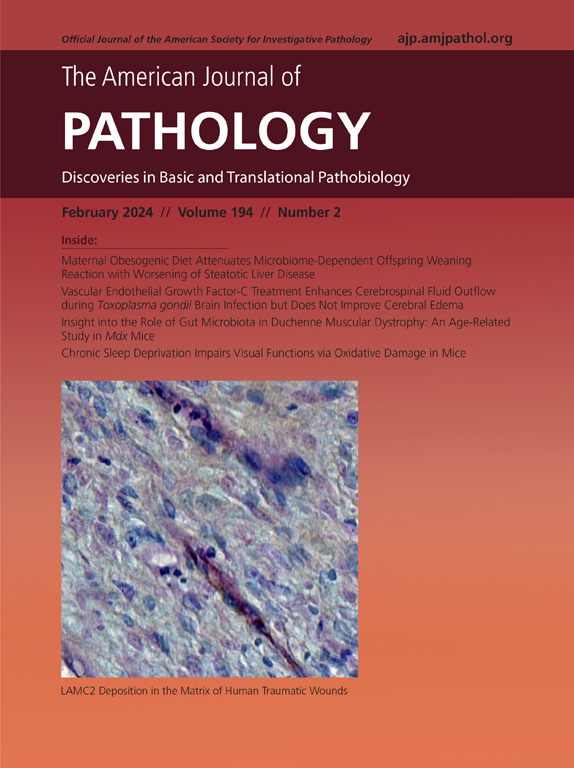A Disintegrin and Metalloproteinase 10 Regulates Ephrin B2–Mediated Endothelial Cell Sprouting and Ischemic Retinopathy
IF 3.6
2区 医学
Q1 PATHOLOGY
引用次数: 0
Abstract
Retinal neovascularization is the leading cause of visual impairment in diabetic retinopathy, retinopathy of prematurity, and age-related macular degeneration. The extracellular matrix breakdown by metalloproteinase leads to vascular complications in various proliferative retinopathies. A disintegrin and metalloproteinase domain-containing protein 10 (ADAM10) is involved in physiological angiogenesis. However, limited information exists regarding the role of ADAM10 in proliferative retinopathies. In this study, the levels of active ADAM10 were significantly up-regulated in the ischemic retina, and down-regulation or inactivation of ADAM10 significantly inhibited the proliferation, sprouting, migration, and tube formation of human retinal microvascular endothelial cell. Furthermore, the endothelial cell (EC)–specific deletion of ADAM10 (ADAM10iΔEC) significantly attenuated vascular leakage, edema, endothelial cell sprouting, and retinal neovascularization in ischemic retinas of mice exposed to oxygen-induced retinopathy. In experiments investigating the mechanisms through which ADAM10 regulated pathologic angiogenesis, ADAM10 regulated ephrin B2 (EfnB2) expression in endothelial cells. Down-regulation of EfnB2 expression influenced human retinal microvascular endothelial cell proliferation, migration, sprouting, and tube formation. In addition, a significant up-regulation of EfnB2 expression in the ischemic retina was detected. EC-specific depletion of ADAM10 significantly reduced EfnB2 expression, suggesting its involvement in ADAM10-regulated retinal neovascularization. The findings demonstrate how EC-specific ADAM10 regulates pathologic retinal neovascularization in the ischemic retina, indicating its significance as a potential therapeutic target for proliferative retinopathies.
崩解素和金属蛋白酶10调控Ephrin b2介导的内皮细胞发芽和缺血性视网膜病变。
视网膜新生血管是糖尿病视网膜病变、早产儿视网膜病变和年龄相关性黄斑变性中视力损害的主要原因。金属蛋白酶破坏细胞外基质可导致各种增生性视网膜病变的血管并发症。研究表明,崩解素和金属蛋白酶结构域蛋白10 (ADAM10)参与生理性血管生成。然而,关于ADAM10在增殖性视网膜病变中的作用的信息有限。本研究发现,在缺血视网膜中,ADAM10的活性水平显著上调,ADAM10的下调或失活显著抑制人视网膜微血管内皮细胞的增殖、发芽、迁移和成管。此外,内皮细胞(EC)特异性缺失ADAM10 (ADAM10iΔEC)可显著减轻氧诱导视网膜病变小鼠缺血视网膜的血管渗漏、水肿、内皮细胞发芽和视网膜新生。在了解ADAM10调控病理性血管生成机制的同时,观察到ADAM10调控内皮细胞中ephrin B2 (EfnB2)的表达,下调EfnB2表达影响人视网膜微血管内皮细胞的增殖、迁移、发芽和成管。此外,在缺血视网膜中检测到EfnB2表达显著上调,ec特异性缺失ADAM10显著降低EfnB2表达,提示其参与ADAM10调节的视网膜新生血管形成。这些发现表明ec特异性ADAM10如何调节缺血视网膜的病理性视网膜新生血管,表明其作为增殖性视网膜病变的潜在治疗靶点的意义。
本文章由计算机程序翻译,如有差异,请以英文原文为准。
求助全文
约1分钟内获得全文
求助全文
来源期刊
CiteScore
11.40
自引率
0.00%
发文量
178
审稿时长
30 days
期刊介绍:
The American Journal of Pathology, official journal of the American Society for Investigative Pathology, published by Elsevier, Inc., seeks high-quality original research reports, reviews, and commentaries related to the molecular and cellular basis of disease. The editors will consider basic, translational, and clinical investigations that directly address mechanisms of pathogenesis or provide a foundation for future mechanistic inquiries. Examples of such foundational investigations include data mining, identification of biomarkers, molecular pathology, and discovery research. Foundational studies that incorporate deep learning and artificial intelligence are also welcome. High priority is given to studies of human disease and relevant experimental models using molecular, cellular, and organismal approaches.

 求助内容:
求助内容: 应助结果提醒方式:
应助结果提醒方式:


